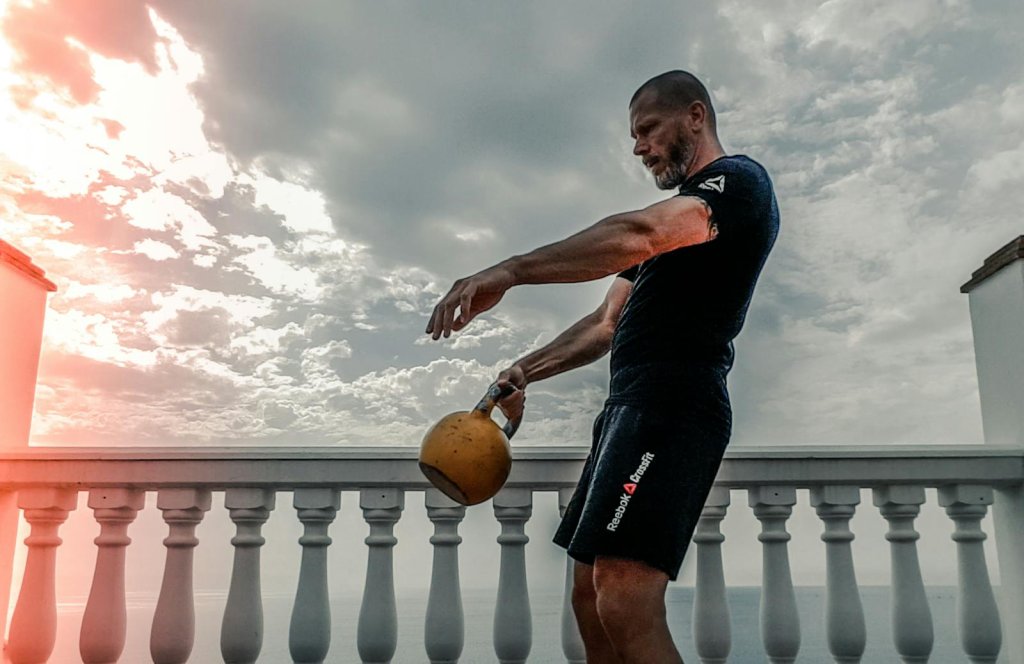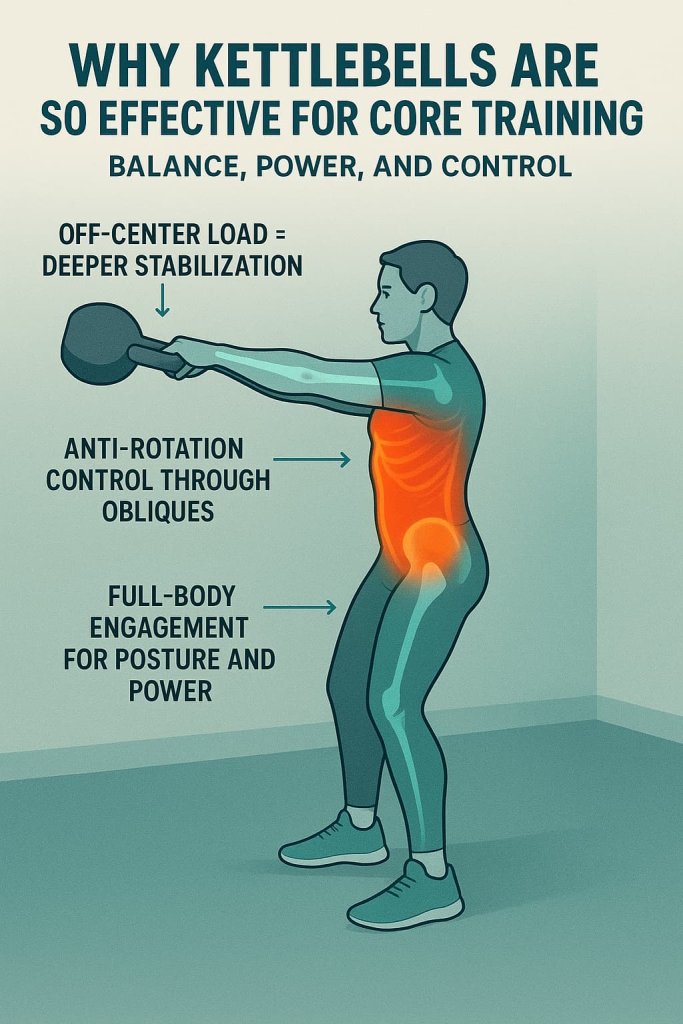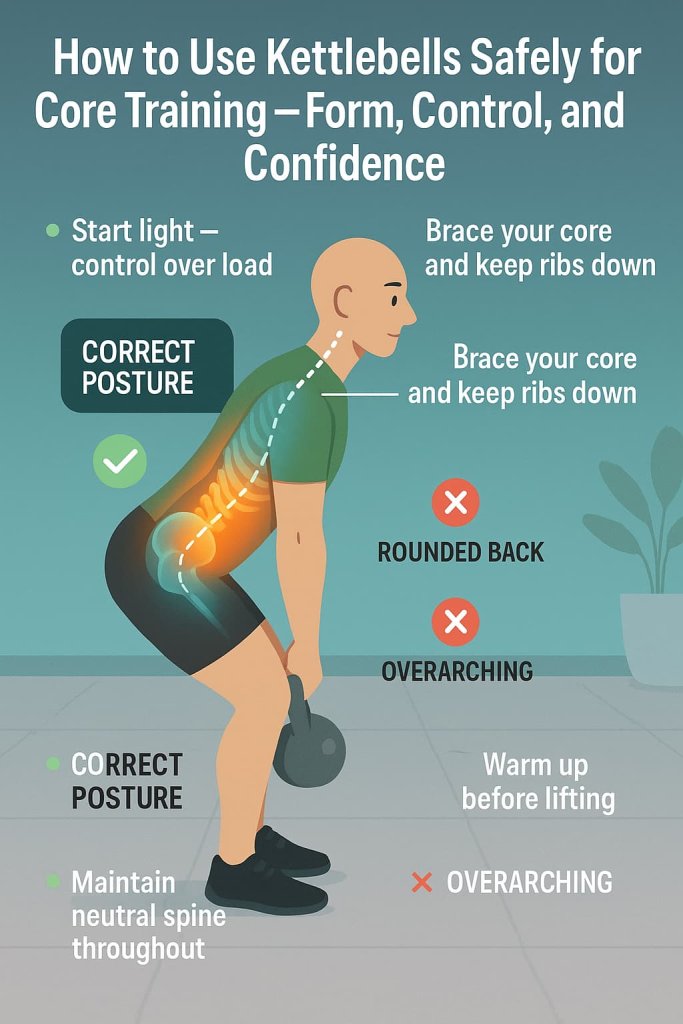Kettlebell core exercises are one of the most effective ways to strengthen your abs, improve balance, and enhance overall body stability. The off-center design of the kettlebell forces your trunk muscles to work harder to resist rotation, making it far superior to traditional crunches or sit-ups.

A strong core does more than sculpt your midsection — it protects your spine, improves posture, and boosts performance in everything from lifting to running. This guide covers the 15 best kettlebell core exercises, complete with technique cues, key muscle targets, and pro tips to help you build strength safely and efficiently.
Why Kettlebells Are So Effective for Core Training
Unlike fixed weights, kettlebells have a shifted center of gravity that constantly challenges your stabilizing muscles. Every swing, press, or carry demands balance, control, and anti-rotation strength.

Key Benefits
- Engages deeper stabilizers (transverse abdominis, multifidus, and obliques)
- Builds real-world functional strength for lifting, twisting, and bending
- Improves posture and balance through core alignment
- Boosts calorie burn and endurance due to full-body engagement
Research Insight:
A 2024 Frontiers in Sports and Active Living study found that kettlebell exercises produce significant activation of trunk stabilizers compared to traditional resistance training. Another ACE Fitness study reported measurable gains in core endurance after 8 weeks of structured kettlebell workouts.
How to Use Kettlebells Safely for Core Training

Proper form and progression keep kettlebell core workouts effective and injury-free.
- Start Light: 4–6 kg for women, 8–12 kg for men; master control before adding weight.
- Warm Up: Do 5–10 minutes of hip and shoulder mobility drills.
- Brace Your Core: Breathe steadily and keep your spine neutral during every movement.
- Prioritize Form: Stop if balance or posture breaks — quality beats load.
- Seek Guidance: If you feel pain, consult a trainer or physiotherapist.
15 Best Kettlebell Core Exercises
These kettlebell core exercises strengthen your abs, obliques, and lower back while improving posture and full-body control.
Each move combines stability, strength, and coordination to help you build a stronger, more functional midsection.
1. Kettlebell Turkish Get-Up
Why it works:
This full-body exercise integrates mobility, stability, and strength through every major joint. It demands your core to remain tight as you transition from the ground to standing while keeping a weight overhead. The multi-planar movement activates stabilizers that protect your spine and shoulders, improving coordination and functional strength.
Muscles worked:
Rectus abdominis, obliques, transverse abdominis, glutes, hip flexors, shoulders, and erector spinae.
How to do it:
- Lie flat on your back, holding a kettlebell overhead with one arm, elbow locked.
- Bend the same-side knee and plant your foot firmly on the floor.
- Press into the floor to roll up onto your opposite elbow, then your hand.
- Drive through your planted heel to lift hips off the ground.
- Sweep your extended leg under your body into a kneeling lunge position.
- Press into your front heel and stand tall with the kettlebell overhead.
- Reverse each step to return to the starting position under control.
Trainer Tip:
Keep your eyes on the kettlebell throughout the movement to maintain shoulder stability and alignment. Start with a light weight or even bodyweight to learn the sequence before progressing.
2. Kettlebell Windmill
Why it works:
The windmill strengthens the obliques and spinal stabilizers while enhancing shoulder and hip mobility. Holding the kettlebell overhead trains anti-lateral flexion and balance through controlled side bending, making it excellent for core endurance and posture.
Muscles worked:
External obliques, erector spinae, glute medius, hamstrings, and shoulder stabilizers.
How to do it:
- Stand with feet wider than shoulder-width and hold a kettlebell overhead in one hand.
- Turn your feet about 45° away from the kettlebell.
- Keeping eyes on the weight, hinge your hips toward the opposite side and slide your free hand down your leg.
- Pause when you feel a deep stretch in your hamstrings and obliques.
- Engage your core to return to the upright position.
Trainer Tip:
Keep the kettlebell directly over your shoulder and spine neutral. Limit the range if your shoulders or hamstrings feel tight.
3. Kettlebell Swing
Why it works:
The swing builds explosive hip power while forcing your abs and spinal muscles to stabilize against the kettlebell’s momentum. It’s one of the most effective moves for training the posterior chain and core together.
Muscles worked:
Glutes, hamstrings, erector spinae, transverse abdominis, and grip muscles.
How to do it:
- Place a kettlebell a foot in front of you.
- Stand with feet shoulder-width apart and hinge at the hips, grabbing the handle.
- Hike the kettlebell back between your legs, maintaining a flat back.
- Drive hips forward powerfully to swing the kettlebell to chest height.
- Let it swing back down naturally as you hinge again.
Trainer Tip:
Focus on hip drive — not arm strength. Keep your core braced, spine neutral, and glutes engaged at the top of each rep.
4. Kettlebell Plank Pull-Through
Why it works:
This move combines plank stability with dynamic load shifting. Pulling the kettlebell under your body challenges your obliques and shoulders to resist twisting — an essential skill for real-life strength.
Muscles worked:
Transverse abdominis, obliques, shoulders, glutes, and lower back.
How to do it:
- Start in a high plank with the kettlebell beside your right hand.
- Reach under your chest with your left hand to drag the bell to your left side.
- Keep hips square to the floor.
- Alternate sides for each repetition.
Trainer Tip:
Slow, controlled pulls build more core strength than fast drags. Widen your stance if your hips start rotating.
5. Kettlebell Russian Twist
Why it works:
A rotational powerhouse, this exercise targets the obliques and rectus abdominis, improving core rotation and control. The kettlebell’s offset weight increases resistance and stability demands.
Muscles worked:
Obliques, rectus abdominis, transverse abdominis, hip flexors.
How to do it:
- Sit with knees bent, heels on the floor, and lean back slightly.
- Hold a kettlebell by the horns at chest level.
- Twist your torso to bring the kettlebell toward the floor beside one hip.
- Rotate back through center and repeat to the opposite side.
Trainer Tip:
Avoid swinging the weight — keep movements slow and deliberate to engage your core fully.
6. Kettlebell Suitcase Carry
Why it works:
This functional core exercise teaches your body to resist lateral bending while walking. It enhances postural control, spinal stability, and grip strength.
Muscles worked:
Obliques, erector spinae, glutes, and forearms.
How to do it:
- Hold a kettlebell in one hand at your side.
- Stand tall with shoulders square and abs braced.
- Walk 10–20 meters slowly, keeping your torso upright.
- Switch hands and repeat.
Trainer Tip:
Do not lean toward the kettlebell. Keep ribs stacked over your pelvis and imagine your spine as a straight pole.
7. Kettlebell Halo
Why it works:
The halo challenges shoulder stability and activates your upper core by moving the kettlebell around your head in a controlled arc. It’s great for improving shoulder mobility and upper-body coordination.
Muscles worked:
Deltoids, upper abs, obliques, and scapular stabilizers.
How to do it:
- Hold the kettlebell by the horns at chest height.
- Circle it slowly around your head, keeping elbows tucked.
- Maintain a tight core and upright posture.
- Reverse direction after several reps.
Trainer Tip:
Avoid flaring ribs or arching your back. Keep the movement smooth and close to your head.
8. Kettlebell Renegade Row
Why it works:
Combining a row with a plank, this exercise develops total core stability while training your back and arms. It teaches you to resist rotation under load.
Muscles worked:
Lats, obliques, abs, triceps, and lower back.
How to do it:
- Start in a high plank, hands gripping two kettlebells.
- Row one kettlebell to your side while keeping hips level.
- Lower it back down and switch arms.
Trainer Tip:
Keep your body in a straight line from head to heels. Avoid rotating your torso or letting your hips drop.
9. Kettlebell Dead Bug
Why it works:
Enhances deep core activation and coordination by integrating limb movement with trunk stability — ideal for reinforcing proper spinal alignment.
Muscles worked:
Transverse abdominis, obliques, rectus abdominis, hip flexors.
How to do it:
- Lie on your back holding a kettlebell above your chest.
- Lift both knees to 90 degrees.
- Lower your right arm and left leg simultaneously while keeping your back flat.
- Return to start and switch sides.
Trainer Tip:
Move slowly and maintain contact between your lower back and the floor to prevent strain.
10. Kettlebell Half-Kneeling Chop
Why it works:
Trains diagonal core patterns that support athletic movement, improving rotational control and anti-twist strength.
Muscles worked:
Obliques, rectus abdominis, shoulders, glutes, and hip stabilizers.
How to do it:
- Kneel with one knee down and one foot forward.
- Hold a kettlebell with both hands at shoulder height.
- Bring it diagonally down across your body toward your opposite hip.
- Return to the start position with control.
Trainer Tip:
Lock your hips and move from your torso. Focus on tension — not speed.
11. Kettlebell Side Plank Row
Why it works:
Blends isometric oblique engagement with pulling power, creating a unique combination of strength and stability.
Muscles worked:
Obliques, lats, shoulders, triceps.
How to do it:
- Set up in a side plank with your forearm on the floor and a kettlebell in front.
- Row the kettlebell toward your torso while keeping hips high.
- Lower slowly and repeat.
Trainer Tip:
Keep your shoulders stacked. Beginners can rest the bottom knee for support.
12. Kettlebell Single-Leg Deadlift
Why it works:
A top-tier functional move that trains balance, hip hinge mechanics, and unilateral stability. It prevents asymmetries and strengthens the posterior chain.
Muscles worked:
Glutes, hamstrings, erector spinae, obliques.
How to do it:
- Hold a kettlebell in one hand and stand on the opposite leg.
- Hinge forward at the hip, extending your free leg behind you.
- Keep the kettlebell close to your shin as you lower it.
- Return to standing by engaging your glutes and core.
Trainer Tip:
Keep your hips square to the floor. If you wobble, touch your back foot lightly for balance.
13. Kettlebell Front Rack March
Why it works:
A dynamic stability drill that strengthens your core while mimicking everyday balance demands like walking or climbing stairs.
Muscles worked:
Core stabilizers, hip flexors, glutes, and shoulders.
How to do it:
- Hold a kettlebell in rack position at shoulder height.
- Brace your core and lift one knee toward hip level.
- Lower it slowly and switch sides.
- Continue marching for time or reps.
Trainer Tip:
Stay tall and resist leaning or twisting — your core should do the work.
14. Kettlebell Overhead Carry
Why it works:
This movement builds total-body tension and shoulder stability. Carrying a weight overhead demands spinal alignment and strong anti-extension control.
Muscles worked:
Deltoids, abs, erector spinae, glutes, and traps.
How to do it:
- Press a kettlebell overhead with your arm fully extended.
- Walk forward slowly while keeping ribs down and core tight.
- Maintain straight posture throughout the carry.
Trainer Tip:
If your back arches or ribs flare, use a lighter weight or shorten the walk distance.
15. Kettlebell Clean to Press
Why it works:
Combines lower- and upper-body strength with dynamic stability. The hip-driven clean builds power, while the press strengthens your shoulders and core in one seamless motion.
Muscles worked:
Core, shoulders, triceps, glutes, hamstrings, and lats.
How to do it:
- Swing the kettlebell from between your legs up to the rack position at shoulder level.
- Brace your core and press the kettlebell overhead until your arm is fully extended.
- Lower to rack position, then swing it back to start.
Trainer Tip:
Keep the kettlebell close to your body to protect your wrist. Avoid arching your lower back during the press — stay braced and tight.
Common Mistakes to Avoid
- Overarching the back during swings or presses
- Using arms instead of hips for power
- Twisting or leaning during carries
- Neglecting breathing and core bracing
- Starting too heavy before mastering form
Programming Tips
| Goal | Sets | Reps/Duration | Frequency |
|---|---|---|---|
| Core Strength | 3–4 | 8–12 reps | 2–3× per week |
| Endurance | 2–3 | 45–60 s holds | 2× per week |
| Stability | 3 | 30 m carries or 10 reps/side | 2–3× per week |
Alternate between anti-rotation, anti-extension, and carry movements for complete core development.
Safety and Precautions
- Warm up 5–10 minutes before training (e.g., hip circles, light swings).
- Start with lighter weights (4–6 kg for women, 8–12 kg for men).
- Avoid advanced overhead or single-leg moves if you have shoulder or back pain.
- Focus on form before intensity — poor technique negates core benefits.
- Always consult a doctor or physiotherapist if you have pre-existing injuries.
This content is for informational purposes only and not medical advice.
FAQs
Q1. Can kettlebell core exercises replace crunches?
Yes — they train deeper stabilizers and build functional strength, not just surface muscles.
Q2. How often should I train my core with kettlebells?
Two to three times per week is ideal for most people.
Q3. What weight should beginners start with?
Women: 4–6 kg (9–13 lb); Men: 8–12 kg (18–26 lb) — focus on control.
Q4. Are kettlebell swings safe for beginners?
Yes, if learned correctly. Start with slow hip hinges before adding power.
Q5. Can this help reduce belly fat?
Kettlebell training boosts calorie burn and muscle activation, but fat loss depends on diet and overall activity.
Q6. Should I do kettlebell core workouts before or after lifting?
After your main strength work — fatigued core muscles can affect heavy lifts.
Q7. Do I need multiple kettlebells?
No, one moderate-weight kettlebell is enough for most exercises.
Conclusion
Kettlebell core exercises don’t just build visible abs — they train your body to move, lift, and stabilize with strength and confidence. By combining dynamic movements like swings and get-ups with static holds and carries, you’ll create a resilient, powerful midsection that supports every activity.
Start light, focus on form, and stay consistent. Within weeks, you’ll notice better posture, stronger lifts, and a more functional, stable core.
References
- McGill SM, Marshall LW. Kettlebell swing, snatch, and bottoms-up carry: back and hip muscle activation and spine loading. Journal of Strength and Conditioning Research (2012).
Link: https://pubmed.ncbi.nlm.nih.gov/?term=Kettlebell+swing%2C+snatch%2C+and+bottoms-up+carry%3A+back+and+hip+muscle+activation+and+spine+loading - Lake JP, Lauder MA. Mechanical demands of the kettlebell swing. Journal of Strength and Conditioning Research (2012).
Link: https://pubmed.ncbi.nlm.nih.gov/?term=Mechanical+demands+of+the+kettlebell+swing+Lake+Lauder - Farrar RE, Mayhew JL, Koch AJ. Oxygen cost of kettlebell swings. Journal of Strength and Conditioning Research (2010).
Link: https://pubmed.ncbi.nlm.nih.gov/?term=Oxygen+cost+of+kettlebell+swings+Farrar+Mayhew+Koch - Jay K, Jakobsen MD, et al. Kettlebell training for musculoskeletal and cardiovascular health: randomized controlled trial. Scandinavian Journal of Work, Environment & Health (2011).
Link: https://pubmed.ncbi.nlm.nih.gov/?term=Kettlebell+training+for+musculoskeletal+and+cardiovascular+health+randomized+controlled+trial+Jay
